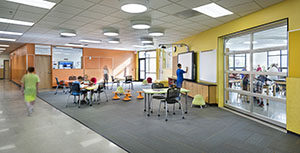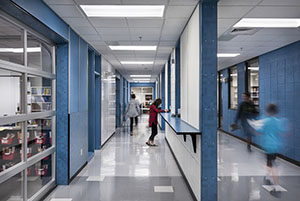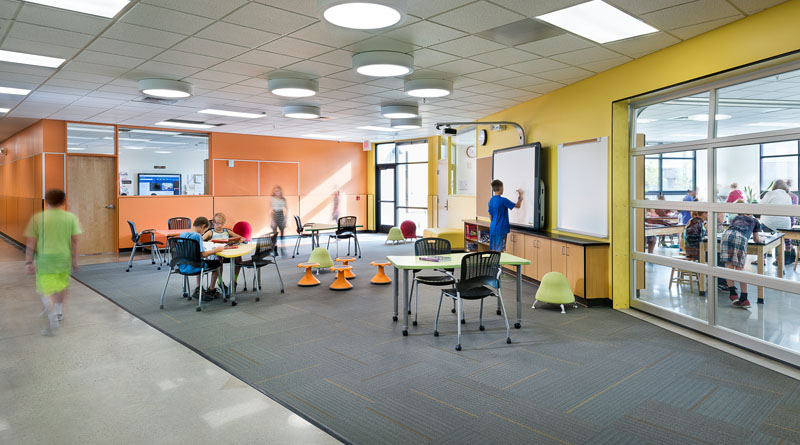Part II: Creating Flexible, Dynamic Classrooms and Shared Spaces
BILLINGS, Mont. — Enrollment at Elysian K-8 School in Billings has doubled in recent years due to a flourishing local medical community and increasing nearby energy exploration, requiring a school remodel and expansion.
After passing a bond issue in 2013, work began on a nearly $8 million, 66,000-square-foot renovation and expansion project at Elysian K-8 School, which can now accommodate up to 480 students. Plans called for creating an innovative educational environment that would surpass any other in the region, maintaining the school’s high performance in state standards testing and complementing innovative single-family housing developments nearby.

The Elysian school district determined that local Billings firm A&E Architects was the best choice for the school project. For added expertise on educational interior design, A&E Architects brought in Seattle-based partner and nationally recognized Integrus Architecture.
Eleven Amarr 3552 Heavy-Duty Aluminum Full View Sectional Doors specified by Integrus comprised a critical design element in the project. Each door features a wide expanse of 1⁄2-inch-thick clear tempered glass between 2-inch extruded clear anodized aluminum rails and stiles. The ClearView aluminum struts add strength and durability to the doors without restricting the viewing area and allowing the maximum amount of natural light.
Part I of this article explored how the full-view doors helped break down traditional classroom barriers. Here, we’ll explore how the project has improved flexibility and student engagement — as well as how the project benefited from BIM technology.
Flexibility and Expansion
A&E Architects’ Dusty Eaton, AIA, LEED AP, architect and principal, explained that part of the rationale for the full view doors was based on the need for increased flexibility and the ability to expand classroom sizes on an as-needed basis. “When a door (or combination of doors) is open, that quickly increases classroom space and allows students to move into shared break-out areas so they can easily dive into a cross-disciplinary and collaborative teaching environment,” Eaton said.
For example, while one class is focusing on a science lesson and another class is working on math problems, once the door opens, the two classes can quickly combine into one space to share findings from their respective lessons.
Eaton pointed out that he’s seen this in action in the school’s Yellowstone Room, which acts as an art/science makerspace. Once the full-view door is open, students can spill out from up to three classrooms and then go into full collaborative project mode.
“The most significant aspect of the full-view door concept is the glass itself,” Eaton explained. “It really helps to make the classroom and shared spaces feel larger when the doors are closed.”
BIM Software
Sam Schafer, AIA, senior associate and project architect with Integrus Architecture, shared that when designing the school’s interior, his firm used Autodesk Revit BIM (building information modeling) software, which helped to clearly demonstrate to the school board, superintendent and teachers the full-view doors’ placement and how they would be used.

“Full-view doors are a great way to bring natural daylight from exterior windows into a deeper floor plate than a traditional relight approach,” Schafer said. “The doors, especially in the new elementary portion of the school, really help bring more borrowed light into the classroom spaces and shared areas. This has also reduced the need for teachers to turn on overhead lights during sunny days.”
Schafer added that designing the doors into Elysian’s project involved addressing a few important safety details early in the process. For example, the design had to take into account fire sprinkler placement. “When the doors are open [they] block the sprinkler head on that part of the ceiling, so we needed to add an extra sprinkler head to cover that space,” he said.
Students Interaction
Eaton also emphasized that the full-view doors essentially serve as a flexible, dynamic and changing architectural wall element. Students can write on them with colorful dry-erase markers, or decorate them with artwork and other projects to make them their own.
“The final product clearly shows the level of commitment of everybody involved, including our firms, the general contractor, dealer/installer, the school board and the community who, all combined, embraced the potential of opportunity for what the school could become,” Schafer said.
“Initially, those involved on the project committees didn’t understand the concept of placing ‘garage doors’ in classrooms,” Eaton pointed out. “But once they understood it and saw it in action, the lights came on. They all agreed it’s a brilliant approach to dynamic education as well as community interaction and involvement.”

